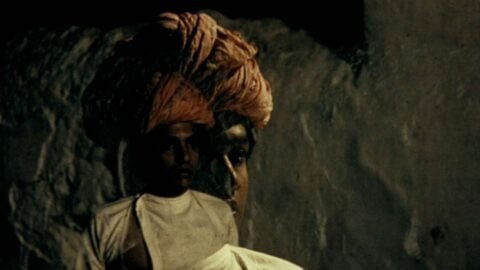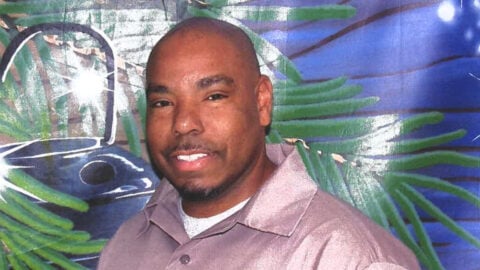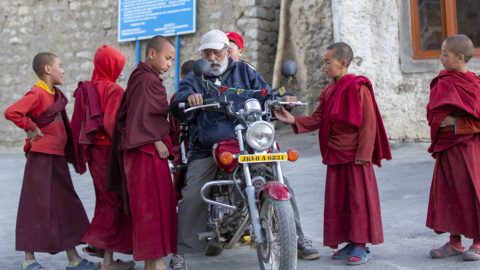Interview: Takashi Makino
The experience of watching Takashi Makino’s work is perhaps best expressed by the title of one of his films: still in cosmos. On the one hand, the filmmaker attempts to create a pure frenzy through the use of multiple exposure and superimposition, but there always remains a notion that abstract chaos exists within some sort of greater order. This paradoxical tension has persisted in all aspects of his filmmaking. At times his films confront you with the visual equivalent of a shriek; in other moments, they feel completely tranquil.
Makino’s work is steeped in the avant-garde traditions of abstract animation and artisanal practice represented by the likes of Jordan Belson and Stan Brakhage, but the techniques that he employs involving digital transfers, increased frame rates, and multiple layering also push digital technology forward to the edge of its current abilities. While his films may appear transcendent and otherworldly, they are entirely composed of images from this world, such as the shimmers of light against leaves in Inter View (10), clouds dispersing in In your star (12), and a bird’s-eye view of the Tokyo cityscape in Generator (12). These moments illuminate with blinding intensity but are always full of shadows. Such tensions are the foundation of his practice.
Although Makino’s work continues to eschew story, character, and dialogue, his recent films have marked several turning points that have taken his artistic practice in a new direction. In 2012, Makino shoots with a digital camera and employs the Pulfrich 3-D effect to portray images of ripples spreading on a river surface; Phantom Nebula (14) is his first foray into found-footage filmmaking where human shadows emerge from the dust and scratches accumulated on the filmstrip; and with Space Noise (13-14), in addition to performing haunting ambient noise himself, he has turned it into an amorphous multi-projection work that changes with every presentation.
Makino’s first North American tour of screenings and performances includes a screening of 2012 on October 5 in Projections within the New York Film Festival. For FILM COMMENT, Julian Ross spoke with Takashi Makino via Skype.

2012
In the past you’ve shot on film and digitally superimposed the material to create immersive and layered images. Your film 2012, in a sense, marks a departure as it includes a section that is digitally shot. Can you elaborate on your stance concerning the gap between analog and digital filmmaking?
At first, I considered only shooting on film and projecting the finished work on film for an audience, but I ended up facing many issues, such as the costs involved in making prints. From 2004 onwards, I stopped making works entirely on film, and decided around 2006 to shoot on film but edit and project digitally. That was a big decision for me. At first, it didn’t feel like my own work when it was digitally projected. I was using a Telecine machine at work, transferring film material to video, and came to realize that the technology had arrived at a point where the qualities of film can be preserved after a digital transfer. It had previously taken me two to three years to make one film, and when I made the shift I was suddenly able to make four or five a year. Around the same time, digital projectors became much better, and I realized that the time has come for me to accept it.
Still, I wanted to keep shooting on film. The reason was because the contrast resolution is different, which is important because I create my images using the technique of multiple exposure. Layering film has a different effect to layering digitally, as physical photosensitive particles get mixed together, which doesn’t happen as smoothly with pixels. Between 2011 and 2012, when film seemed to be facing a crisis of extinction, I felt I might no longer be able to shoot on film. Laboratories were shutting down in Japan and abroad. I had to ask myself whether I could work completely digitally or whether I’d have to quit making the style of films I make. When I started making 2012, I thought film might no longer exist by the end of the year. I told myself I would only make one film during the year, in which the first section would be shot on film and the latter would be shot digitally, to mark this transition. This was decided from the outset.

2012 Act 5
You presented the film 2012 in different versions throughout the year 2012, before settling on a final version in 2013. What was the thinking behind this?
Again, it had to do with the difference between analog and digital film. One thing that sets digital apart from analog is that you can screen exactly the same film as many times as you want because it doesn’t deteriorate. Film, on the other hand, is susceptible to changes every time it is projected. Strictly speaking, it is never exactly the same. I wanted to challenge the notion of showing the exact same film to an audience, which had become a possibility with digital projection. I wanted to make a work that could only be seen once every time it was projected. Every time it was shown, I added new sounds and changed the images. By performing the music live, I also wanted to add an element of physicality to the screening. I made it so it was required that I would be present at the screening. I put together these rules and I wanted to abide by them for this film. I wouldn’t be able to do this forever, so I only did it during the year 2012 and completed the film at the end of the year.
Did you encounter any surprises shooting on a digital camera?
As expected, there was quite a difference in contrast resolution between analog and digital film. At first I worried, because multiple exposure on digital material doesn’t have the same depth as something shot on film. I was working as a colorist at the time, where I adjusted the color and image contrasts when digitizing film prints. I tried applying the same techniques that I used for my job with what I had shot on video, which unexpectedly worked out.
Nevertheless, I think most people can tell when the film switches to digitally shot material. Even when you digitally scan film using 4K resolution, you can tell the difference in quality. For example, a hand would appear a little fuzzy on its contours when shot on film, as if there was no clearly demarcated border between the hand and its surroundings. When you layer such images, they bleed into each other nicely. When the image is shot on a digital camera, the pixels create clear borders, no matter how high the definition. It’s actually not suited to my style of production.
You sometimes screen a 3-D version of 2012. Can you explain why?
It’s connected with the physicality that I wanted this film to have. While considering the physicality of analog and digital film, I thought of the screening as an experience. I wanted the audience to be able to decide how to perceive the film. I hand out glasses so that the images can appear to rotate outwards to the left when you hide your left eye, and vice versa, due to the Pulfrich effect that gives an illusion of depth. The film will appear to be different when you use the glasses but you’re also welcome to watch it without them. In Hollywood films, it is already pre-determined how to look at a 3-D image, and the area of the image that will poke out at you has already been decided for you. There is no variety of experience among the individual spectators.

Space Noise (screening at Issue Project Room, Brooklyn, on October 8)
I consider Space Noise to be a continuation of this approach to filmmaking. Space Noise doesn’t seem to have a complete version, as it changes every time it is presented to an audience. Will Space Noise ever arrive at a final version?
The idea behind Space Noise is to project film and video onto the screen at the same time and have that as the foundation of its development. Rather than changing it every time, I add more images every time it is projected. In a sense, Space Noise is a flexible project and has a looser concept than 2012. I’ve performed live music for Space Noise separately with Manuel Knapp, Jim O’Rourke, and Floris Vanhoof. Space Noise can become an installation or a performance, but it will never be completed as a film. The aim of the project is to attempt to reach the limits of abstraction, which is naturally an endless endeavor.
Could you talk about your collaborations with other filmmakers? For Deorbit [13], you collaborated with Telcosystems from the Netherlands. They’re digital artists but you work with analog film.
Telcosystems don’t shoot images. They don’t even edit. All their images are produced from a system they have devised on a computer. Yet, sometimes our films that are made in such different ways appear to have similarities. Over the years, we’d been discussing how strange but exciting this is. Telcosystems, who are also members of the organization Sonic Acts, invited me to collaborate on Vertical Cinema, their newest project where artists were commissioned to make site-specific works for a custom-built projector that projected 35mm celluloid in vertical cinemascope.
We edited analog film material I shot together with the digital noise Telcosystems created. We added the images of scratches on the film material into the digital system that Telcosystems created, and experimented with new ways of creating digital noise in real-time, which was captured and then used as raw material for the edit. Telcosystems also downloaded lots of satellite images of earth from the NASA website, which was also used as raw material.

Deorbit (screening as part of Vertical Cinema at Leeds International Film Festival on November 7)
Watching your other films, I feel the abstractions often use a horizontal motion. And lateral motion is actually essential for 2012, because it allows for the Pulfrich effect to work. But, of course, Deorbit operates vertically.
I shot lots of raw material on cinemascope but it just looked imbalanced when I shifted the image vertically. When I adjusted my mind to the vertical format, I noticed that I began to select images with downward and falling motion, such as a waterfall and rain. I suppose it’s a bit like a hanging scroll painting. Telcosystems and I were editing while shooting, and discussing the images, so I stopped recording horizontal movements, which had become a habit when I made films on the 16×9 format. The falling motion is also connected to the title Deorbit, which was conceived from the idea of something in space falling out of orbit.

Phantom Nebula (screening at the Center for New Music, San Francisco, on October 26)
You just completed your newest film, Phantom Nebula, which, at 60 minutes, is also your longest. Judging by Ghosts of OT 301 (14), which you describe as something of a preview, you seem to be departing from total abstraction with the presence of human figures.
For the first time, I decided not only to use images that I shot myself, but also found footage. Actually, I was thinking about not making abstract films altogether after 2012, as my intentions were to bring together all the technical skills that I had learned for the film in order to reconsider what I want to do from now. It was a turning point for me. I had always made abstract films in order to trigger images in the audience’s mind. Whenever I brought concrete images into the mix, your eyes couldn’t help but be drawn towards them, which is why I never used them. I came up with the idea to use concrete images but reduce their concreteness in order for them to remain abstract. This is what motivated me to make Phantom Nebula. I wanted to go beyond abstraction and arrive at a concrete abstraction.
I did something similar with the sound. Although the first half includes music that I made myself, I gradually incorporate sounds from older narrative films. I wanted to rethink the relationship between sound and image, and try producing new relationships in collage format. The film is divided in three parts according to the primary colors of red, blue and green, with 20 minutes each. The third section in the film includes a lot of play on symmetry, using the shapes of eyes, bodies, and symbols that almost look ritualistic. When Telcosystems were making digital noise, there were moments where the image got stuck and became bilaterally symmetrical. We considered it a malfunction and didn’t use it for Deorbit, but I experienced seeing images differently when this suddenly happened.
When I thought about it, I realized many things in our universe are constructed symmetrically, including our bodies and, to an extent, how trees grow. This approach of bringing symmetry into the equation provided me with new forms of abstraction. These images started to look like a nebula, which is why I gave the film its title.







